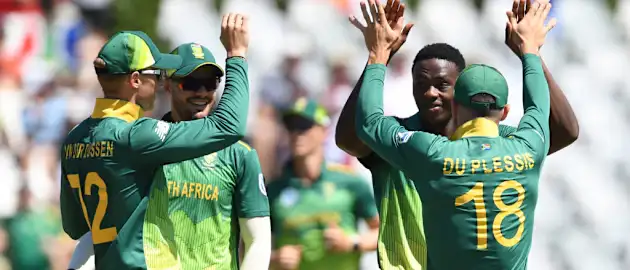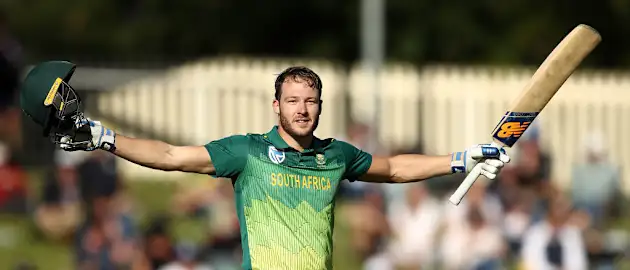Five takeaways from South Africa's CWC19 squad


There weren’t a whole host of surprises, but seasoned campaigner Hashim Amla, who was seemingly far from guaranteed to earn a spot, has been included, while there’s no specialist back-up 'keeper for the ever-impressive Quinton de Kock. His fitness remains imperative from both a batting and wicket-keeping perspective.
Here we list the five main talking points from South Africa’s provisional World Cup squad list.
BREAKING: South Africa announce their squad for #CWC19! 🇿🇦 pic.twitter.com/TuTeY9bX0c
— ICC Cricket World Cup (@cricketworldcup) April 18, 2019
Lethal pace attack, but how do you fit them all in?
Kagiso Rabada will spearhead a frightening pace attack, with Andile Phehlukwayo also a likely starter. That potentially leaves Dale Steyn, Lungi Ngidi, Anrich Nortje and Dwaine Pretorius fighting it out for the other one or two fast-bowling berths, with the latter boosted by his all-rounder status.
The pacemen’s form and fitness are likely to go a long way to determining how far the Proteas progress. There is of course no Duanne Olivier; he has turned his back on international cricket to sign a three-year deal with English county side Yorkshire.
Tahir's ODI swansong
PAK v SA - Imran Tahir Feature
With Imran Tahir, who has claimed 162 wickets from 98 ODIs at 24.21, bowing out of ODI cricket after the ICC Men's Cricket World Cup 2019, will the classy Pakistan-born leg-spinner sign off in style before he joins the world of T20 franchise cricket?
Tahir has not shown any signs of slowing down in recent years: since the 2015 World Cup, he has 92 scalps at 27.46 with an economy rate comfortably under five.
Amla in, battle for a top-order berth continues
Hashim Amla has been included in South Africa's #CWC19 squad!
— ICC (@ICC) April 18, 2019
FULL SQUAD⬇️https://t.co/uCvQVrQleK pic.twitter.com/JS9P4emTRb
South Africa have failed to nail down an opening partnership in ODI cricket. De Kock is a guaranteed starter at the top, but should his partner be Amla, who has struggled in the recent past, or Aiden Markram, who has flirted with form but failed to deliver on a consistent basis?
Rassie van der Dussen, also capable of opening and whom has also made the cut, is likely to stay at No.4. The 30-year-old averages 88.25 from his nine ODIs to date – all of which have come this year – boosted by four not outs and the same number of fifties.
Reeza Hendricks, meanwhile, who has been tried at the top but only averages 26.76 from 18 ODI matches, has been left out altogether.
Shamsi provides second spin option
South Africa are set to announce their #CWC19 squad today!
— ICC (@ICC) April 18, 2019
Who should accompany Quinton de Kock at the top? Will Heinrich Klaasen be the reserve 'keeper?
The key questions. ⬇️https://t.co/Ehq8FoWxIo
All eyes will be on 29-year-old Tabraiz Shamsi with this tournament likely to provide the left-arm wrist spinner with an opportunity to prove that he can be a long-term replacement for the departing Tahir. Big shoes to fill, admittedly.
With only two front-line spin bowlers named – JP Duminy also provides useful, part-time darts – and wrist-spin a potent weapon in England, there’s every chance Shamsi will line-up alongside the veteran regularly. He has taken 19 wickets at 35.89 in 15 ODIs, including best match-figures of 4/33.
Miller to be de Kock’s deputy

South Africa have opted against selecting a front-line wicket-keeper as back-up to De Kock. In 14 ODIs, Heinrich Klaasen hasn’t quite grasped his opportunity: he has scored just 251 runs at 22.81. It means David Miller will have to pick up the mantle as both back-up glovesman and chief middle-overs destroyer.
Miller recently took up the gloves during the second ODI against Sri Lanka at Centurion, though he wasn’t a complete stranger to the role, having kept for both KwaZulu-Natal Inland Under-19s and Dolphins (albeit once in a three-day game). "I'm just trying to make sure the ball gets in the hands,” he said after the Sri Lanka match. Sound advice.
Another option is van der Dussen, who has also donned the gloves at provincial level.